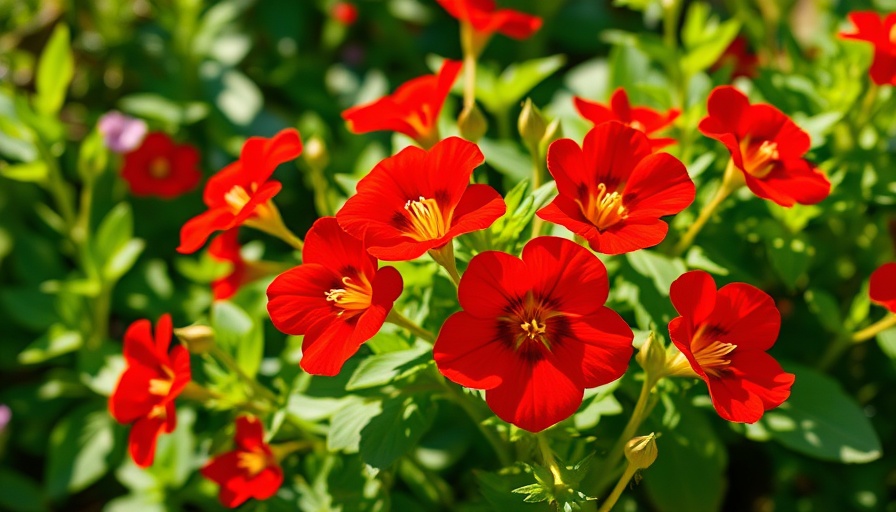
The Colorful World of Nasturtiums: A Beginner's Guide
If you've ever wandered into a garden filled with bright, cheerful colors, you might have come across the striking nasturtium. Often seen as simple yet stunning, these edible flowers deserve more attention than they generally receive. Perfect for those looking to enhance their salads or brighten up their garden space, nasturtiums thrive in poor soil conditions and require minimal maintenance. Their vibrant colors not only lift the spirits but are also a delight in culinary creations, making them an ideal addition to any garden.
Understanding the Different Varieties
Nasturtiums belong to the genus Tropaeolum, which encompasses around 80 species, predominantly from the Andes Mountains of Bolivia and Colombia. The most popular variety among gardeners is the annual T. majus. Yet, with such diversity, the choice can be overwhelming. Here are fifteen particularly beloved nasturtium varieties that stand out for their beauty and usability:
- Alaska
- Apricot
- Black Velvet
- Empress of India
- Fiesta Blend
- Indian Chief
- Jewel Mix
- Orange Gleam
- Orchid Flame
- Peach Melba
- Phoenix
- Purple Emperor
- Vesuvius
- Whirlybird Mix
- Yeti
Growing Nasturtiums: Key Considerations
Before delving into nasturtium care, it's essential to know the types available—trailing or bushy. Trailing varieties, with their larger blooms, are visually stunning in hanging baskets or cascading over beds. However, bush types offer a compact and manageable growth pattern, making them wonderful for window boxes or borders. This choice can significantly influence the overall design of your garden. Consider the space you have and how these colorful plants will fit into your landscaping or garden decor.
The Benefits of Growing Nasturtiums
What makes nasturtiums particularly appealing is not only their beauty but also their ability to act as natural pest repellents. These flowers can help deter unwanted visitors while fostering a healthy environment for neighboring plants. By incorporating nasturtiums into your vegetable gardening routines, you can proactively combat garden pests, allowing your crops to flourish without harsh chemicals.
Nasturtiums: Edible Elegance for Your Plate
While their aesthetic appeal is undeniable, nasturtiums shine in the kitchen as well. Their peppery flavor adds a delightful kick to salads and other dishes. They can be used to garnish meals, providing an elegant touch to your culinary creations. The flowers and leaves are both edible and can be incorporated into various recipes, making them fantastic not just for the garden but for your culinary endeavors too.
Companion Planting with Nasturtiums
By integrating nasturtiums into your gardening projects, you also open doors for companion planting. These vibrant flowers are excellent neighboring plants for many vegetables—especially kale, cucumbers, and cabbage—helping to ward off pests that might otherwise attack your cherished crops. This natural form of garden pests control is an excellent strategy for organic gardening enthusiasts seeking to cultivate a thriving, pesticide-free garden.
Actionable Tips for Thriving Nasturtiums
To get the best out of your nasturtium plants, follow these effective gardening tips:
- Soil Quality: They thrive in poor soils, so over-fertilizing can diminish their vibrancy. A well-drained soil environment is ideal.
- Water Management: These flowers prefer moderate water. Ensure they receive consistent watering but avoid waterlogging.
- Sunlight Requirements: Nasturtiums enjoy sunny spots; ensure they get at least six hours of sunlight daily.
- Harvesting: Regularly pinch back flowers to encourage bushier growth and a continuous bloom cycle.
Whether you're making your first foray into gardening or looking to add a splash of color and flavor to your plate, nasturtiums present a wonderful option. With their ease of care and myriad uses, they're a fabulous choice for anyone looking to enhance their flower garden or vegetable layout.
Conclusion: Embrace the Nasturtium in Your Garden
Incorporating nasturtiums into your gardening efforts not only beautifies your space but also enhances your meals and environment. With their pest-repelling and culinary qualities, they are more than just a pretty face in your garden. Explore the diverse varieties available, and take the first steps into a rewarding world of edible blooms that will inspire both your gardening spirit and culinary creativity!
 Add Row
Add Row  Add
Add 




Write A Comment